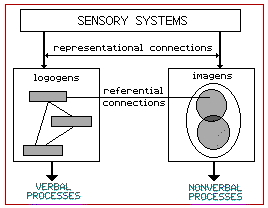
Overview:
The dual coding theory proposed by Paivio attempts to give equal weight to verbal and non-verbal processing. Paivio (1986) states: "Human cognition is unique in that it has become specialized for dealing simultaneously with language and with nonverbal objects and events. Moreover, the language system is peculiar in that it deals directly with linguistic input and output (in the form of speech or writing) while at the same time serving a symbolic function with respect to nonverbal objects, events, and behaviors. Any representational theory must accommodate this dual functionality." (p 53).

The theory assumes that there are two cognitive subsystems, one specialized for the representation and processing of nonverbal objects/events (i.e., imagery), and the other specialized for dealing with language. Paivio also postulates two different types of representational units: "imagens" for mental images and "logogens" for verbal entities which he describes as being similar to "chunks" as described by Miller. Logogens are organized in terms of associations and hierarchies while imagens are organized in terms of part-whole relationships.
Dual Coding theory identified three types of processing: (1) representational, the direct activation of verbal or non-verbal representations, (2) referential, the activation of the verbal system by the nonverbal system or vice-versa, and (3) associative processing, the activation of representations within the same verbal or nonverbal system. A given task may require any or all of the three kinds of processing.
Scope/Application:
Dual coding theory has been applied to many cognitive phenomena including: mnemonics, problem-solving, concept learning and language. Dual coding theory accounts for the significance of spatial abilities in theories of intelligence (e.g., Guilford). Paivio (1986) provides a dual coding explanation of bilingual processing. Clark & Paivio (1991) present dual coding theory as a general framework for educational psychology.
Example:
Many experiments reported by Paivio and others support the importance of imagery in cognitive operations. In one experiment, participants saw pairs of items that differed in roundness (e.g., tomato, goblet) and were asked to indicate which member of the pair was rounder. The objects were presented as words, pictures, or word-picture pairs. The response times were slowest for word-word pairs, intermediate for the picture-word pairs, and fastest for the pciture-picture pairs.
Principles:
1. Recall/recognition is enhanced by presenting information in both visual and verbal form.
References:
Clark, J. M. & Paivio, A. (1991). Dual coding theory and education. Educational Psychology Review, 3(3), 149-170.
Paivio, A. (1971). Imagery and Verbal Processes. New York: Holt, Rinehart & Winston.
Paivio, A. (1986). Mental Representations. New York: Oxford University Press.
Paivio, A. & Begg, I. (1981). The Psychology of Language. New York: Prentice-Hall.